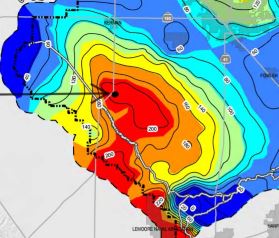up close with government acronyms
As previously briefed, we can expect a mandate reducing and ultimately prohibiting overdrafting of our aquifer supply. Legislation was signed into law in 2014 to be overseen by the California Department of Water Resources. Specifically, the Sustainable Groundwater Management Act ( SGMA ) is a compliance framework that delegates responsibility to local level management entities to develop and implement a plan toward that end.
Our farm property lays within the local jurisdiction of the McMullin Area Groundwater Sustainability Agency (MAGSA ) or GSA for short. The GSA is developing and implementing a plan to be approved and tracked by the state and will have the authority to assess fees, adopt rules and conduct enforcement. Our GSA must work collectively with other GSAs under the direction of a Joint Powers Authority GSA (Fresno County and its 2 Water Districts).
Plan development must be complete by year 2020. Coincidentally, our previous ranch manager, Don Cameron, is a director and co-chairman of the Raisin City Water District and thereby one of the five board members of the Joint Powers Authority GSA. He is a prominent voice and is active in the direction of GSA policy as you will note further on.
Responsibility
The MAGSA must determine its over-drafting responsibility for the region. Realize that the aquifer is vast and does not recognize political boundaries. As you might surmise neighboring GSAs will make a case that “their” groundwater share is flowing into and being used up by ours. It has been [unofficially] estimated that 125,000 acre feet of groundwater is over-drafted in the MAGSA each year.

A solution (?)
A possible plan to achieve sustainability (Don Cameron’s) involves the idea of replenishment through the diversion of flood water flows when they naturally occur. These flows, which would otherwise be lost to the sea, would instead be funneled to select crop land holding areas within the GSA. Over time the standing water would join the aquifer through gravitational percolation or perhaps more quickly by way of dry wells — a reverse pumping concept or groundwater recharge. Funding for recharge study and actual testing have been conducted by Don Cameron as proof of concept. Phase I of his McMullin On-Farm Recharge Project on Terranova Ranch, Inc land holdings will be completed by the end of this year at a cost of $12 million in federal funding. Don Cameron holds title of Vice President and General Manager at Terranova. Phase I of the project is limited and specific to Terranova. It is not certain that there will be a Phase II or that our location in proximity might be included.
Outcomes
A recent idea, the concept of selling or transferring groundwater rights, is gaining traction. Renewable Energy Credits (REC) have established a precedent which may be applied to irrigation supply. In theory, a farmer who fallows his field and discontinues pumping could sell his share credit as if it were a commodity. A buyer would use his purchase to offset or reduce penalties for what would otherwise be considered an overage. In another example, Terranova might do the same by justifying that their recharge system experiment puts back more than they take out. They enjoy sustainability while marketing the excess credit.
We are hopeful that solutions and agreements can be achieved. Last year we used 993.4 acre feet of water. A scenario might have us reducing pumping by “x” percent in order to do our part. Agony would be GSA failure to meet SGMA established timeline goals and the state assuming restrictive control compounded with significant flowage derived monetary penalties/fees.
Extra credit for enduring the following PowerPoint Presentation: